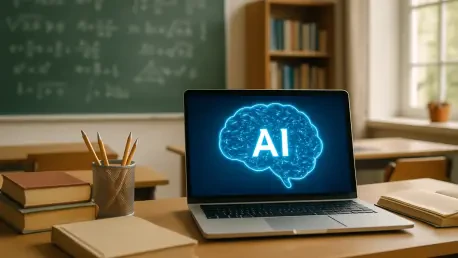What if a single tool could transform the way students learn, teachers teach, and administrators plan—all while saving time and boosting outcomes? Artificial Intelligence (AI) is stepping into classrooms across the nation, promising just that, yet for many educators and parents, this technology feels like a leap into the unknown, raising questions about its role and impact. This exploration delves into how AI is reshaping education, offering a clear path through the uncertainties to reveal its potential for meaningful change.
Why AI Feels Like a New Frontier in Education
The rapid emergence of AI in schools often seems like navigating uncharted waters. Teachers wonder how to balance this powerful tool with traditional methods, while administrators grapple with implementation costs and ethical concerns. Parents, meanwhile, question whether AI might depersonalize learning for their children. These apprehensions are valid, given the complexity of a technology that can analyze data, personalize lessons, and even predict student success.
Yet, beneath the uncertainty lies a transformative opportunity. AI isn’t just another gadget—it’s a means to address long-standing challenges like teacher burnout and unequal access to tailored education. Understanding its place in schools is crucial, as studies indicate that schools using AI tools report a 30% increase in student engagement. This signals a shift worth exploring with an open yet cautious mindset.
The Natural Progression of Technology in Classrooms
Technology’s journey in education has never been a straight line, but rather a series of bold steps forward. From the introduction of computers in classrooms decades ago to the rapid adoption of online platforms during global disruptions, educators have consistently adapted to change. Each transition, though initially daunting, eventually became a cornerstone of modern teaching, proving that adaptation is part of the profession’s DNA.
AI represents the latest chapter in this ongoing evolution. Much like past innovations, it builds on a foundation of proven success—think of how digital tools streamlined record-keeping or expanded access to resources. Today, AI offers capabilities like automating grading and customizing learning paths, positioning it as a logical next step rather than a radical departure. This historical perspective helps frame AI as a familiar challenge, one that schools are equipped to meet.
Reflecting on past shifts also highlights a key lesson: resistance often gives way to mastery with time and support. Educators who once struggled with basic software now rely on it daily. Similarly, AI’s current complexity will likely fade as familiarity grows, reinforcing the idea that this technology is not a barrier but a bridge to enhanced education.
AI’s Tangible Benefits for Schools and Students
AI’s role in education extends far beyond theoretical promise, delivering concrete solutions to real-world problems. Adaptive learning platforms, for instance, adjust content to match each student’s pace, ensuring no one falls behind. Virtual tutors provide on-demand support, helping students tackle difficult concepts outside classroom hours. These tools have led to measurable gains, with some districts reporting a 25% improvement in test scores after implementation.
For educators, AI offers a lifeline by automating time-consuming tasks. Grading essays or crafting lesson plans can now take minutes instead of hours, thanks to specialized software. Early warning systems powered by AI also flag students at risk of falling behind, enabling timely interventions. A case study from a Midwestern school district showed a 40% reduction in dropout rates after deploying such systems, illustrating their impact on retention.
Beyond individual benefits, AI fosters inclusivity by breaking down barriers. Real-time translation tools help non-native speakers engage fully in lessons, making classrooms more accessible. Predictive analytics, meanwhile, assist administrators in forecasting enrollment trends or resource needs. These diverse applications demonstrate that AI isn’t a one-size-fits-all solution but a versatile ally in addressing varied educational needs.
Insights from Experts on AI’s Classroom Impact
Hearing from those at the forefront of education technology brings clarity to AI’s potential. Melody Schopp, PhD, Director of Education Industry Consulting at SAS Institute, shares a grounded perspective from her extensive career. “AI can revolutionize how schools operate, but only with the right mindset and preparation,” she notes, drawing from her experience training teachers on tech tools since earlier decades. Her insight emphasizes that success hinges on intentional adoption.
Schopp’s journey—from guiding South Dakota educators through early digital shifts to championing AI today—underscores a recurring theme: change requires effort but delivers lasting value. She recalls the initial skepticism around video systems in schools, which eventually became indispensable. This parallel suggests that AI, though complex now, can follow a similar path to acceptance and utility with proper guidance.
Policy-level support further validates AI’s growing relevance. Recent federal initiatives, including executive actions to prioritize AI in teacher training grants, signal a national commitment to this technology. Combined with expert voices like Schopp’s, these developments paint a picture of AI as a trusted tool when paired with human oversight and strategic planning, offering reassurance to hesitant stakeholders.
A Practical Guide to Adopting AI in Education
Integrating AI into schools need not be an overwhelming task if approached systematically. Start by selecting tools with a proven track record, such as adaptive learning platforms for students or grading automation for teachers. These solutions should align with specific needs, ensuring relevance and effectiveness. A district in California, for example, saw teacher workload drop by 20% after adopting AI for administrative tasks, highlighting the importance of targeted choices.
Training forms the backbone of successful adoption. Comprehensive professional development programs can demystify AI, equipping educators with the skills to use it confidently. Equally vital is engaging parents through transparent communication about AI’s purpose and benefits, addressing concerns with accessible resources. Regular dialogue builds trust, ensuring families feel included in the process rather than sidelined by unfamiliar tech.
Human oversight remains non-negotiable, especially when decisions impact students. Administrators must monitor AI outputs to prevent errors or bias, while periodic evaluations ensure tools meet intended goals. Embracing the initial learning curve is also key—early efforts may feel burdensome, but the long-term payoff, as seen in reduced workloads and improved outcomes, justifies the investment. This roadmap transforms AI from a daunting concept into a practical asset for any school.
Reflecting on the Path Forward
Looking back, the journey of integrating AI into education mirrored past technological leaps, marked by hesitation yet driven by necessity. Schools that took bold steps to adopt these tools often found themselves ahead, with teachers freed from mundane tasks and students benefiting from tailored learning. The challenges of training and trust-building were met with persistence, proving that adaptation was always within reach.
The next steps rested on a shared commitment to refine this integration. Prioritizing ongoing training and evaluation ensured AI remained a servant of educational goals rather than a distraction. Engaging all stakeholders—educators, parents, and policymakers—fostered a collaborative spirit that turned potential pitfalls into stepping stones. This collective effort promised to shape a future where technology and human insight worked hand in hand.
Ultimately, the focus shifted toward scalability and equity. Efforts concentrated on ensuring every school, regardless of resources, accessed AI’s benefits through targeted funding and partnerships. This vision of inclusivity, built on lessons learned, aimed to redefine education as a space where innovation served every learner, leaving no one behind in the march toward progress.









